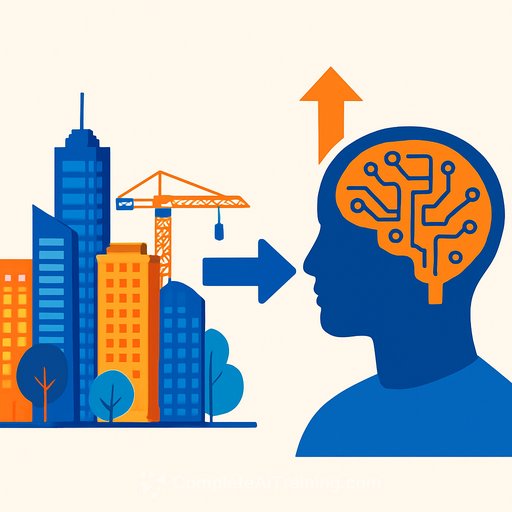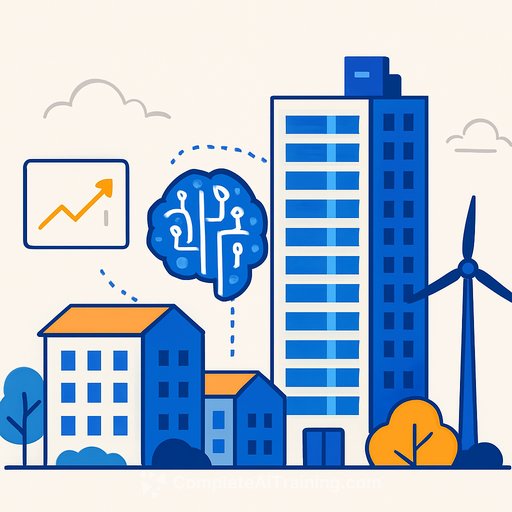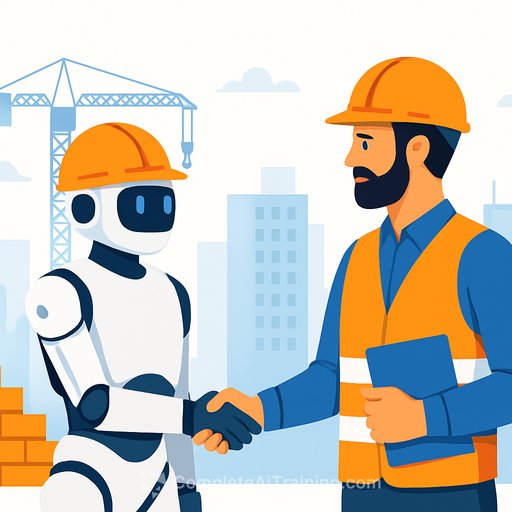AI adoption in the built environment requires a mindset shift
The built environment is primed for AI-driven productivity gains, but most organisations are not set up to capture them. A new global survey of 86 industry leaders shows growing interest, early pilots, and a clear gap between intent and readiness.
Leaders should treat this as a strategic inflection point. The companies that standardise data, upskill teams, and implement strong governance will move faster and win bigger contracts as AI becomes standard across projects.
What the survey says
- 24% are already adapting business models for AI-driven change.
- 40% expect significant AI impact in the coming years, but only 20% consider AI a current strategic priority with plans for wider rollout.
- 36% use generic AI tools (such as Copilot). 26% are trialling AI for specific use cases. 15% have only tested AI selectively.
- Agentic AI (agents with reasoning, planning, self-evaluation) is not widely used yet, though few are ignoring AI entirely.
- Respondents included designers, contractors, project and cost managers, technology providers, and asset owners, with 75% at C-suite/board level across the UK, North America, Australia, and other regions.
Where AI is creating value now
- Automating document processes and knowledge retrieval.
- Real-time monitoring for predictive maintenance and asset performance optimisation.
- Construction productivity optimisation and progress tracking.
- Design and engineering support: generative design, complex simulation, digital twins, and rapid option analysis.
Ian Laing noted this focus clearly: "Optimising and improving the productivity of design and engineering processes is one current area of focus... generative design, complex simulation, digital twinning and rapid analysis of solutions which can help optimise design and engineering solutions."
He added: "Other areas of focus include automating document processes and cost estimation and forecasting."
Designers are moving; contractors are cautious
Two-thirds of architectural and engineering designers are either adapting now or expect major disruption. Contractors are more sceptical: only 12% are actively adapting their business models; 35% expect significant impact within three years, while over half expect limited or no impact.
That confidence gap could be costly. Graham Robinson warned: "While practitioners are sceptical about on-site automation in the short-term, the long-term potential remains high and contractors that ignore this potential may become casualties of the rapid advancement of AI."
His practical advice: start small and safe. "Contractors could pilot AI and robotics in incremental ways now - such as autonomous drones for site surveys or AI for safety monitoring - so as not to fall behind when on-site automation accelerates."
Governance and risk: policy gaps are holding back adoption
- 60% have some form of AI policy, but only 20% have an organisation-wide policy.
- Just 6% have department-level policies with governance, ethics, and safety guidelines.
- 12% have no AI policies at all.
- 37% report limited or no project controls to manage AI risk in design and construction.
Robinson said the risk is real: "Without adequate governance and project controls, AI mistakes could pose safety risks or legal liabilities." He called for AI model validation, peer review of AI-assisted designs, and clear contractual terms on AI use. Regulators may also need to update guidance for AI-assisted engineering.
Outlook: AI use is set to climb quickly
More than two thirds of respondents expect over half of their projects to significantly use AI in design and construction within three years. Only 29% expect similar gains on construction works, leaving headroom for on-site use cases.
With global construction spending projected to hit $10 trillion in 2025, market pressure will grow on delivery models and margins. Source: Oxford Economics
What to do in the next 90 days
- Pick 2-3 high-yield use cases: document automation, cost estimation, design iteration, safety monitoring, predictive maintenance.
- Run controlled pilots: define KPIs (time saved, error rate, rework), conduct peer review, and keep humans in the loop.
- Tighten data foundations: standardise file structures, naming, and metadata; map data flows from design to site to operations.
- Set policy and controls: organisation-wide AI policy, department guidelines, model validation steps, and clear contract clauses on AI use and IP.
- Upskill your teams: train designers on generative tools, PMs on AI-assisted controls, and site teams on AI-enabled safety and QA.
6-12 month roadmap
- Scale winners: move proven pilots into standard workflows and templates.
- Expand to agent workflows: explore agentic AI for RFI responses, submittal checks, schedule look-aheads, and design optioning with guardrails.
- Strengthen vendor strategy: focus on interoperability, data ownership, security, and auditability.
- Integrate with PMO: embed AI metrics into project controls, risk registers, and monthly reporting.
Cultural shift: from experiments to operating model
Laing called for investment to move a siloed, fragmented industry to an integrated, data-driven one. That requires funding, cross-functional ways of working, and clear incentives for teams.
Robinson stressed skills and culture: expecting a jump to majority-AI projects in three years requires a shift in industry conservatism and faster progress on data standards and workforce training.
If you need structured upskilling for teams adopting AI in design, delivery, or asset operations, explore practical courses and certifications at Complete AI Training.
The takeaway
The sector is interested but underprepared. Focus on use cases that save hours now, put guardrails in place, and invest in skills. Move from sporadic pilots to repeatable workflows-and the productivity gains will compound across your portfolio.
Your membership also unlocks:






